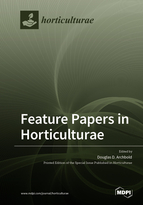Feature Papers in Horticulturae
A special issue of Horticulturae (ISSN 2311-7524).
Deadline for manuscript submissions: closed (31 October 2020) | Viewed by 79886
Special Issue Editor
Interests: fruit set and development; polyol metabolism; ripening and senescence;aroma volatiles
Special Issues, Collections and Topics in MDPI journals
Special Issue Information
Dear Colleagues,
For this Special Issue of ‘Feature Papers in Horticulturae’, high-quality mini-reviews, reviews, and original papers on select topics in the research areas of our Editorial Board members are being sought. The goal of this SI is to highlight, through selected works, frontier research in basic to applied horticulture. Horticultural research at the plant level has been undergoing fundamental changes to improve crop plants due to the emergence of new biochemical and molecular techniques. In addition, integration of new technologies with the desire to develop more sustainable production systems has also spurred production level research. We encourage Editorial Board members of Horticulturae to contribute papers reflecting the latest progress as well as new opportunities in their research field, or to identify and/or invite relevant experts and colleagues to contribute. In addition, contributed manuscripts from those not on the Editorial Board are welcomed.
Prof. Dr. Douglas D. Archbold
Guest Editor
Manuscript Submission Information
Manuscripts should be submitted online at www.mdpi.com by registering and logging in to this website. Once you are registered, click here to go to the submission form. Manuscripts can be submitted until the deadline. All submissions that pass pre-check are peer-reviewed. Accepted papers will be published continuously in the journal (as soon as accepted) and will be listed together on the special issue website. Research articles, review articles as well as short communications are invited. For planned papers, a title and short abstract (about 100 words) can be sent to the Editorial Office for announcement on this website.
Submitted manuscripts should not have been published previously, nor be under consideration for publication elsewhere (except conference proceedings papers). All manuscripts are thoroughly refereed through a single-blind peer-review process. A guide for authors and other relevant information for submission of manuscripts is available on the Instructions for Authors page. Horticulturae is an international peer-reviewed open access monthly journal published by MDPI.
Please visit the Instructions for Authors page before submitting a manuscript. The Article Processing Charge (APC) for publication in this open access journal is 2200 CHF (Swiss Francs). Submitted papers should be well formatted and use good English. Authors may use MDPI's English editing service prior to publication or during author revisions.
Keywords
- genomics
- metabolomics
- genome editing
- protected culture
- sustainable systems
- precision agriculture
- digital technologies
- robotics






